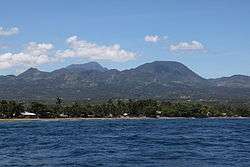Mount Talinis
| Mount Talinis | |
|---|---|
| Cuernos de Negros | |
 | |
| Highest point | |
| Elevation | 1,903 m (6,243 ft) [1] |
| Listing | Potentially active volcano |
| Coordinates | 9°15′0″N 123°10′0″E / 9.25000°N 123.16667°ECoordinates: 9°15′0″N 123°10′0″E / 9.25000°N 123.16667°E |
| Geography | |
.svg.png) Mount Talinis Location within the Philippines | |
| Location | Negros |
| Country | Philippines |
| Region | Negros Island Region |
| Province | Negros Oriental |
| Geology | |
| Age of rock | Late Miocene[2] |
| Mountain type | Complex volcano |
| Volcanic arc/belt | Negros Volcanic Belt |
| Last eruption | Unknown |
Mount Talinis, also known as the Cuernos de Negros (Horns of Negros), is a complex volcano in the Philippine province of Negros Oriental. At about 1,903 metres (6,243 ft)[1][3] above sea level, it is the second highest mountain on Negros Island after Mount Kanlaon. The volcano is located 9 km (5.6 mi) southwest of the municipality of Valencia; and 20 km (12 mi) from Dumaguete City, the capital of the province.
Geology
Cuernos de Negros is classified by the Philippine Institute of Volcanology and Seismology as a potentially active volcano forming part of the Negros Volcanic Belt. Andesite and basalt are the most abundant rocks found on the mountain. With a base diameter of 36 kilometres (22 mi), the volcanic complex is composed of several volcanic cones and peaks, the most prominent of which are Talinis, Cuernos de Negros, Guinsayawan, Yagumyum Peak and Guintabon Dome.[4] The mountain range is very fumarolic with several solfataras and steam vents located on its slope that are harnessed to generate electricity. The Southern Negros Geothermal Production Field in Palinpinon generates 192.5 MW.[5][6]
Tourism
Cuernos de Negros volcanic complex is popular with visitors for the natural beauty of the forest and many volcanic lakes surrounded by mountains.

Balinsasayao Twin Lakes Natural Park
Within the volcano complex is Balinsasayao Twin Lakes Natural Park, a national park established on November 21, 2000 by Proclamation No. 414. It is a most visited park of which the twin crater lakes of Balinsasayao and Danao are located, separated only by a narrow mountain ridge.[7] Lake Kabalin-an, a smaller lake, is located before the two lakes. All three lakes are located within the Guintabon Caldera.[8][9]
Hiking Mount Talinis
Mt. Talinis is easily climbed via nature trails that start in Bidjao, Dauin and Apolong, Valencia.[10][11] Several crater lakes exits: Lake Yagumyum is between Yagumyum Peak and the main peak of Cuernos de Negros; Lake Nailig and Lake Mabilog are crater lakes near the summit. Lake Nailig serves as the main camping ground, with the peak accessible by a 30-minute trek. The summit is heavily forested and mostly covered with fog.[12] The Kaipohan sulfur vents, an area of dead trees and bleached rocks, can be found on the trail to Apolong, Valencia.
Biodiversity

The region of Mt. Talinis has a rich biodiversity that is threatened by illegal logging, "kaingin", increased tourist activity and the gradual build-up of houses near its forested areas. The lakes around Mt. Talinis contain freshwater shrimp, snails, carp and tilapia species, and its forest system is home to endemic and rare wildlife. There are 91 tree species, 18 of which are commercially important, including Alphonsea arborea, Elaeocarpus monocera, Pometia pinnata, and Phyllocladus hypophyllus and tigerwood. Other notable flora include wild orchids, edible berries and, broad-leafed tree ferns.
Common fauna include boars, civets, chickens, pigeons, monkeys, sunbirds, monitor lizards, bar-bellied cuckoo-shrikes, leopard cats, and the brown weaver ant. Some of the endangered and rare animals are tarictic hornbills, Philippine spotted deers, Visayan warty pigs, Philippine tube-nosed fruit bats, and Negros bleeding-hearts.[13]
See also
- List of active volcanoes in the Philippines
- List of potentially active volcanoes in the Philippines
- List of inactive volcanoes in the Philippines
- Philippine Institute of Volcanology and Seismology
- Lakes in the Philippines
External links
- Philippine Institute of Volcanology and Seismology (PHIVOLCS) Cuernos de Negros Page
- Cuernos de Negros on Global Volcanism Program
- Hiking Mt. Talinis from Pinoy Mountaineer: Guide to Hiking in the Philippines
References
- 1 2 Mountaineering Page from geocities
- ↑ Taylor, Brian and Naitland, James Preston. "Active margins and marginal basins of western Pacific", p.119. American Geophysical Union, Washington DC, 1995.
- ↑ Dumaguete City Info
- ↑ "Cuernos de Negros Synonyms and Subfeatures". Global Volcanism Program. Retrieved on 2011-08-07.
- ↑ "Geothermal Projects - Southern Negros Geothermal Production Field (SNGPF)". Energy Development Corporation. Retrieved on 2011-08-07.
- ↑ "Plant Profile - Palinpinon Geothermal Power Plant". PSALM Philippines. Retrieved on 2011-08-07.
- ↑ geocities.com, MT TALINIS (CUERNOS DE NEGROS)
- ↑ "Protected Area in Region 7". Philippine Protected Areas and Wildlife Bureau. Retrieved on 2011-08-08.
- ↑ (2009-11-20). "Indulge in the Charm of Negros Oriental". Weekend Haven. Retrieved on 2011-08-07.
- ↑ negroschronicle.com, Mount Talinis of Valencia
- ↑ negrosanon.org, Lakes Yagumyum & Nailig in Mt. Talinis
- ↑ (2009-06-05). "Mt. Talinis/Bediao-Apolong Traverse to Casaroro Falls (1,903+)". Pinoy Mountaineer. Retrieved on 2011-08-08.
- ↑ gmanews.tv/story, "The Birth of Wonders" and "Dumaguete Diaries"